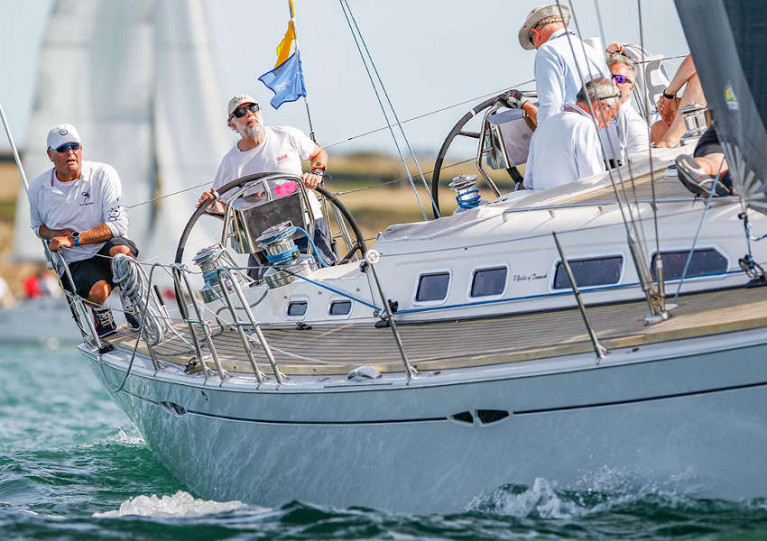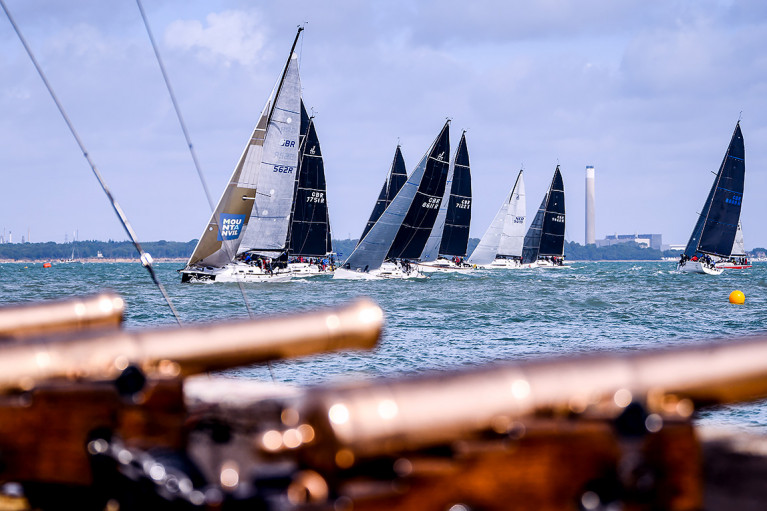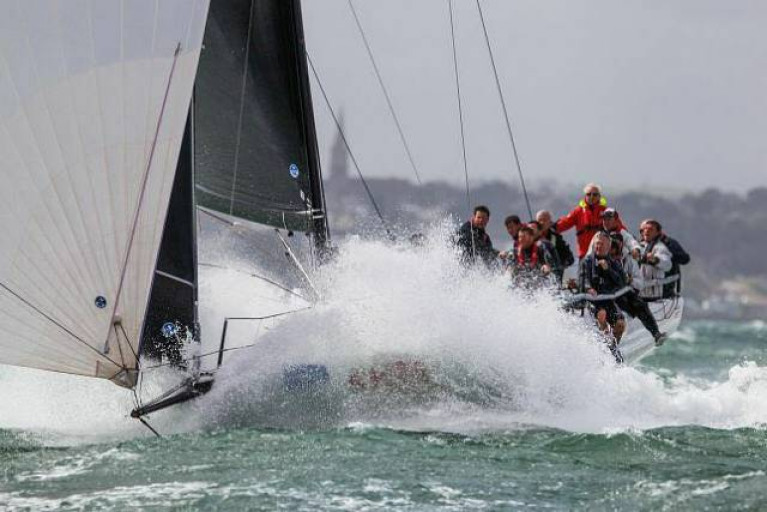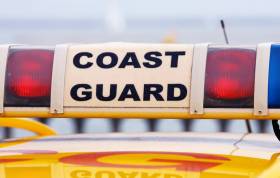Displaying items by tag: Cowes Week
Cowes Week 2021 Opens For Entries
Entries for Cowes Week 2021 will open at 12 noon on Monday 29 March.
Whilst this is somewhat later than usual, the event is carrying over nearly 200 entries from 2020 and the team have been inundated with questions about the opening of the entry website so have every expectation that it will be a bumper year for entries.
For 2021, there will be eight IRC classes, Black Group One Designs such as the J/109 as well as 17 One Design Day Boat classes in the White Group.
A completely new class to Cowes Week this year is the Club Cruiser Division where it is planned to run two starts each day, depending on the number of entries. There will be a further four starts in the Performance Cruiser Division. The decision was taken to split cruisers into Performance and Club divisions to recognise the very different performance characteristics across the range of yacht designs, as well as the sometimes more family orientated crew lists in the Club cruisers. The team behind Cowes Week believe this will deliver high-quality racing for everybody, with similar boats and like-minded crews in the different divisions and are delighted to be able to offer a new trophy for the Club Cruiser Division sponsored by The Cruising Association.
The first-ever Cowes Week opening party will take place on Saturday, July 31st after race day one.
For the first time there will be a daily prize giving, open to all competitors, to be held on the Parade at 18:00 hours each day celebrating the race winners across the regatta, which is hoped will become a great social occasion in its own right. After the prize giving there will still be plenty of time to enjoy all of the social events throughout the town, at yacht clubs, pubs, bars and restaurants, all subject to the Covid guidelines in place at that time.
Cowes Week Organisers Hopeful for 2021 — But It Will Be a Smaller Affair
A more subdued Cowes Week is on the cards for 2021, without the usual Red Arrows flypast and fireworks display.
But as the Isle of Wight County Press reports, efforts are being made to encourage a community event to breathe life into Cowes, which saw last year’s regatta cancelled in the first months of the coronavirus pandemic.
“What we would like to have is a thriving town event,” said Cowes Week director Laurence Mead. “Things must be better than August 2020. What we do is Covid dependent, but we’re optimistic.”
The County Press has more on the story HERE.
Cowes Week Announces Cancellation of the 2020 regatta
Cowes Week Limited (CWL), organiser of the UK's largest and best-known sailing event, has today announced the cancellation of the 2020 Cowes Week regatta.
The move was largely anticipated given the size of the regatta (over 1,000 boats) and large numbers of associated shoreside activities.
The CWL team had hoped that it would be possible to hold the much-loved regatta this summer for the competitors, sponsors and spectators who come together to make it a success. However, despite the encouraging progress that is being made towards the UK's recovery from the COVID-19 pandemic, it's clear that running a large event in nine weeks' time, that will bring many thousands of visitors to the small town of Cowes, will not be possible while sufficiently protecting all those involved.
Laurence Mead, Regatta Director, said "We know that this will be a huge disappointment to many, as indeed it is to the team at Cowes Week. We waited for as long as we realistically could to see how the situation might develop, on the basis that our competitors would want us to run the regatta if it were possible. We appreciate the patience that everybody has shown while we have worked through different scenarios and would like to thank the hundreds of volunteers who have been on stand-by, ready to jump into action if needed."
Kate Johnson, Commercial & Marketing Director, added, "We're grateful to our sponsors, who have been understanding while we worked through our plans and have been willing to stand with us during this very difficult time. We know this will be disappointing for them, but also know that they agree that the health and safety of everyone concerned needs to be our primary consideration and that they view this as a responsible decision. We very much look forward to working with all our sponsors on next year's event."
Competitors already entered will be contacted in the next few days and will be invited to roll over their 2020 entry to the 2021 regatta, when Cowes Week will be back as the highlight of the UK sailing season on its traditional dates of July 31 to August 7.
Cowes Week Still On Schedule For August Regatta
Cowes Week organisers say they are continuing to work from home on all aspects of this year’s event which is still scheduled to take place from 8-15 August.
Regatta director Laurence Mead said: “We continue to move forward with plans for the event and remain hopeful that by the time we get to mid-August – still four months’ away - the necessity to socially distance ourselves will have reduced sufficiently so that we can run some great boat racing in Cowes.
“We can react quickly to changes in the [UK] Government restrictions and guidance, switching on or off various components with the minimum of lead time, and allowing us significant leeway – perhaps until the beginning of July - before we need to make any big decisions.”
Mead added: “The safety of participants and the hundreds of volunteers working behind the scenes is foremost in our minds, of course, but providing that we can run an event that complies with all guidance in place at the time, then we fully intend to do so.
“I suspect there will be a lot of sailors desperate to get boats on the water by August!”
The Notice of Regatta is set to be issues in the coming days on the Cowes Week website.
Cowes Week: Radical Changes for IRC Cruiser Classes
Cowes Week 2020 will be running nine IRC classes, up from eight last year, as splitting class five into two classes (called A and B) worked really well. Organisers say It enabled them to separate out lighter-weight asymmetric boats, and the feedback from competitors on this was excellent.
Knowing that in advance means it makes sense to rename the classes Zero through Nine, but it won't make a huge difference to the IRC class splits in reality.
Secondly, organisers are splitting the cruiser division into two entirely separate entities, to be called 'Performance Cruisers' (4 divisions as in 2019) and 'Club Cruisers' (2 divisions). Cowes Week will be making racing available for what, in essence, are two entirely different types of boats and will be encouraging people to enter the right division based on their boat type. Modern cruising boats with bulb keels and epoxy construction deserve a class of their own, as do some of the more genuine cruisers, and the two will now be able to race separately.
The new Club Cruiser division will also enable people who have not entered Cowes Week in the past to be able to do so, even if their boats really are set up for cruising most of the time.
More here
Great Britain SailGP Team's Heartbreak on Home Waters
With the first day of racing at Cowes SailGP called off due to gale force winds and rough sea states across the UK and in the Solent, all six teams competing in this inaugural season of SailGP knew that Super Sunday in Cowes Week would be action-packed.
With winds on the Solent holding at between 18-22knots, Dylan Fletcher, Great Britain SailGP Team Helm stated before racing: “I think the hardest part is going to be that reach to run; the first bear away around the top mark. Six boats, with that forecast, we will be getting close to and possibly punching over the 50-knot mark. It’s going to be the first time all six boats are going that fast, that close together, so fingers crossed we all keep it clean and keep the rigs in the sky.”
 Crowds in Cowes to watch the action
Crowds in Cowes to watch the action
Thousands of fans came out in force to cheer on the red, white and blue wingsailed catamaran – a packed grandstand and bustling race village welcomed the home team as they sailed just metres from the shore alongside their five rivals; Australia, China, France, Japan and United States.
Having exceeded expectations to take both wins in Thursday’s official practise racing, the pressure was on for the British to perform on home waters but the team remained level headed going into the day’s racing: “It’s going to be a big day. No doubt the more experienced teams are going to be pushing hard – there’s been a lot of chat between us and them [Australia and Japan] but I’m sure it will mean some good racing”, said Dylan.
Just seconds into the first of three scheduled fleet races, the American team were hit by a gust on the bear away and became the second team, following Great Britain in New York, to capsize the F50. Meanwhile Tom Slingsby’s Australian team stormed ahead as Dylan and team battled for second with rival Nathan Outteridge.
Having rolled the Japanese to jump into second place, the British team suffered a devastating crash, nose diving heavily into the Solent and throwing CEO and wing trimmer Chris Draper somersaulting. Thanks to the team’s tethers, Chris and the rest of the crew remained safely on board with no injuries besides bruises to show for the incident.
Sadly, the damage to the boat was enough that it meant no more racing for the home team. With damage to the fairing, a broken pedestal and hydraulic damage, the British F50 was towed from the race area while a further two races continued without them.
“We were having a fairly safe but good race and when we went bow down we just broke the boat and unfortunately the tech team weren’t able to fix it so that was us – game over for the day”, said a devastated Dylan Fletcher following the incident. “We saw in the practise races that we’re capable of winning, so we need to get our boat back together and show that in the real races.”
Tom Slingsby and his Australian crew had a storming event, winning all three Super Sunday races, breaking the 50 knot barrier during racing and gaining enough points to take the top spot on the overall standings, ahead of Japan.
With a day of no sailing in New York following their capsize and now missing two races in Cowes, the Great Britain SailGP have slid from third to fourth in the standings. Rome Kirby and his American team made a fantastic recovery to go on and race the final two races following their capsize which has pushed them up into third place ahead of the British.
A bitterly disappointing day for Dylan and his team but let’s see what the final in Marseille in September brings.
Isle of White Operator Marks First Year of Hi-Speed Craft Red Jet 7 In Advance of Cowes Week
Afloat has followed the launch of an Irish Sea shipyard built freight ferry Red Kestrel onto an Isle of Wight service for Red Funnel which also operates Hi-Speed passenger catamaran, Red Jet 7 which today marked one-year of service on the Solent.
According to Red Funnel the craft has travelled over 84,000 nautical miles, completed 3,615 round trips and nearly half a million passenger journeys.
Red Jet 7 joined the Isle of White serving fleet on July 17, 2018, and like elder fleetmate, Red Jet 6, was built on the English Channel island by Wight Shipyard Co. representing a £7m investment by Red Funnel.
To date Red Jet 7 has spent almost 3,000 hours at sea since launching last year following a prestigious naming ceremony by the Duchess of Cornwall who officially named the new ferry with the traditional formality of breaking a bottle of champagne on the bow.
The craft is the greenest ferry within the Red Jet group as it utilises a new technology to reduce an environmental footprint, and at four tons lighter than Red Jet 6, has improved fuel consumption which further reduces emissions.
Commenting on the one-year anniversary, Red Funnel CEO, Fran Collins, said: “The launch of Red Jet 7 was another proud day in Red Funnel’s history. We take great pride in our commitment to supporting British shipbuilding and are particularly proud of the fact that she was built on the Island, for the Island, utilising the skills of more than 85 Island-based expert craftsmen.
“In her first 12 months of operation, Red Jet 7 has a earned reliability score of 99 per cent and a punctuality score of 93 per cent, meaning that 99 per cent of all our scheduled crossings went ahead as planned and 93 per cent of crossings departed and arrived on time, with the majority of the shortfall due to adverse weather conditions such as fog and strong winds.
The CEO added "Overall, she’s had a very successful first year and we look forward to many more, especially as we now head into our summer season and concurrently mark another big anniversary – 50 years of hi-speed service, which we’re marking with The Red Funnel Fireworks at Cowes Week on the 16th of August. We can’t wait!”
RS Sailing Releases Statement On Death Of Yachtsman At Cowes Week
#CowesWeek - RS Sailing released a statement expressing its members “deepest sadness” following the death of a sailor during Cowes Week on Friday (10 August).
The man in his 60s was thrown overboard from an RS Elite class yacht in Osborne Bay on Friday afternoon. He was picked up by a RIB and brought ashore but later pronounced dead at St Mary’s Hospital on the Isle of Wight.
“Our thoughts and prayers are with the family and friends, many of whom were racing that day,” the statement from RS Sailing reads. “Those most closely involved could hardly have been more experienced or acted more proficiently. We salute them and their efforts.
“But accidents can happen in almost anything worthwhile that we do, and our lost friend would want us to sail on with a smile and keep on loving it as he was doing right up until tragedy struck.”
Yachtsman Dies at Cowes Week Sailing Regatta
A sailor, rescued from the water at Osborne Bay earlier today, has died at Cowes Week.
According to local sources, Emergency Services were called after a man in his 60s was thrown into the water from an RS Elite class yacht.
A witness said the man had been crewing the yacht before ending up in the water. He was picked up by a RIB and brought ashore.
The police said the man was taken to St Mary's Hospital where he was later pronounced dead. His next of kin have been informed and are being supported by specialist officers.
His death is not being treated as suspicious and investigations are ongoing.
Cowes Week Seeks New Regatta Director
#CowesWeek - Lendy Cowes Week organisers are seeking a new regatta director to replace the departed Phil Hagen.
The job is a year-round, part-time post with responsibility to evolve the on-the-water side of the regatta, in order to build upon Cowes Week’s prominent position on the global sailing calendar.
The organisers are looking for someone who is well-known on the yachting and racing circuit, has the vision to take the racing programme forward, and can work with existing and potential entrants, class associations and organising clubs to ensure the event offers the best possible competitive experience.
“Finding the right regatta director is crucial to continue evolving the event on-the-water,” said Peter Taylor, chair of Cowes Week Ltd. “This is a great opportunity for the incoming regatta director to really make their mark at one of the world’s premier regattas.”
The new regatta director will work as part of a small executive team and also with the member clubs of Cowes Combined Clubs through the regatta’s sailing committee.
The closing date for applications is Monday 6 November with interviews set to be held during the week commencing Monday 13 November.
Anyone interested in the role should request further details by emailing [email protected]




































































